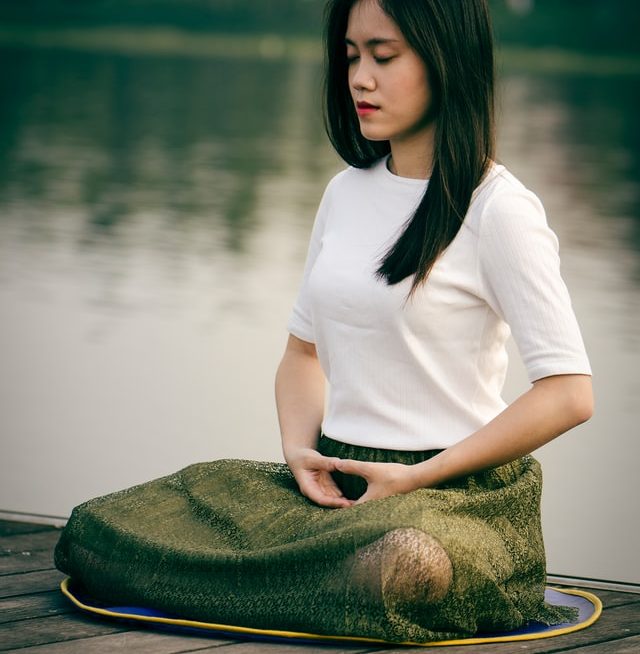If you’re interested in cultivating a meditation practice, here are a few meditation basics to help you get started…and keep going.
While meditation can take many forms, I offer here the form I was taught in Tibetan Buddhism. As you’ll notice, each aspect of the practice carries purpose. These techniques have been cultivated over thousands of years, so the details are not trivial. They remain central to the practice. And, much like in martial arts, the form itself offers instruction. Which is to say: what our bodies do translates to what we want to cultivate in our mind and soul.
The good news, though, is that meditation is incredibly accessible. You don’t need anything fancy to begin.
First, decide where you want to practice. Most people create a small altar area, but you can also find a quiet corner, or sit in front of a window. I do encourage you to use the same space consistently, though. This helps train your body and mind to know what’s coming, and it provides one less interesting tidbit for your mind to process as you begin.
POSTURE
Second, take your seat. The main goal is to have your knees lower than your hips; otherwise you’ll get cramps or your feet will fall asleep. You can either use a cushion(s) and sit cross-legged on the floor, or you can use a chair. If you use a chair, situate yourself at the front of it, so that your back is engaged. Again, we are practicing being awake, and holding your posture is one of the primary ways we practice. And, while we want a strong posture here, don’t be rigid. A common phrase is “upright but not uptight.” One of my teachers would regularly say, “Behind the confidence is always gentleness.” This is the quality we hold in our bodies: the confident strength of an upright spine, a head held high, and our heart and chest soft and open.
As you sit, rest your hands face-down on your knees or thighs, whatever feels most comfortable. Check to see if you feel pulled backward or forward. If so, adjust your hands accordingly. You want them to feel like they help center you, not pull you out of alignment. If you tend to fidget, or if you’re feeling overly distracted, sometimes it helps to place your hands in the Zen mudra, known as dhyani. To do this, rest the back of your right palm on the top of your left palm, and let your thumbs gently touch. (I chose the picture above to show what dhyani looks like.) I tend to begin with palms down, but if I find my mind particularly unwieldy, I switch to dhyani. It helps with focus because you hold your hands just slightly above resting. I find this is often just enough to wake me up.
Because the goal in post-meditation (which is everything that isn’t the time we sit on our cushions) is for us to be awake to the world, we meditate with our eyes open. Set your gaze 5-6 feet in front of you. Keep your eyes soft, not so much that they glaze over, but enough that you aren’t straining on the details. Again, if you find concentration difficult, you can pull the gaze closer in. Keep your head straight, but just shift your eyes more downward. This cuts out some of the peripheral visual noise.
As for your mouth, people tend to find one of these two techniques best. The first is to slightly open your lips, allowing breath to move freely between nose and mouth. Keep this gap small, otherwise you will have cottonmouth, and that’s very distracting! The second option is to keep your mouth closed and rest your tongue gently at the back of your front teeth. I prefer this, because it keeps my mouth from getting dry.
Before you begin, do a quick tension check: are your shoulders down? Are your hands relaxed? What about your jaw? Does your torso feel centered over your hips and bum? You can run a quick body scan and release any tension you are holding.
PRACTICE
Finally, it’s time to begin. Set a timer for the length you’ve chosen. I used to recommend starting small, like five minutes, but I now don’t recommend less than 10 to start. The reason is because it takes 5-8 minutes for your mind just to calm down and get settled, so if you only do five minutes, you don’t ever get past the noisiest part of the practice. I think people often give up because of this. I find that ten minutes is the shortest window possible, but for me, 20 minutes is ideal. It’s doable, it’s sustainable, and usually 10-15 minutes of it allow me to truly practice. (The first five minutes I’m just slogging through and staying committed!)
As for timer, the basic one on your phone works fine. Select a ring tone you enjoy, and preferably one that differs from your other presets. Personally, I use Insight Timer. I like the bell options, and I appreciate having the option to have an interval bell if I’m doing a longer sit.
As you begin, focus on your breath. Let yourself breathe naturally, and simply follow the breath as it flows in and out. As thoughts invade, simply choose not to engage them with your full attention. If you do, no big deal, just bring your attention back to your breath. I’ve found that people can get hung up on “letting thoughts go” so I prefer the idea of moving thoughts to the background. Just let them be background noise. It’s fine for them to be there. But you are not staring them in the face. You will not take any of them to coffee. They are just fellow passengers on the bus.
It helps to remember that the heart of this practice is learning to set your mind in the observer’s seat. Instead of letting your mind drag you all over the place, you are going to train your mind to simply watch the zoo, and not get too riled up about it. Don’t engage. Just observe. Let thoughts stay fuzzy. Return over and over to feeling your breath. Notice it going in and out. No big deal at all, no forcing, just see what happens.
When the bell timer rings, I like to close with a bow to seal my practice.
I hope you find these meditation basics helpful. If you’re new, remember learning something new takes time. Don’t expect nirvana. Just be consistent, and keep showing up. If you’re looking for a great beginner book, I highly recommend Pema Chodron’s How to Meditate.
Maybe this week you can commit to one or two meditation sessions? See what happens when you begin your day by centering your awareness.




